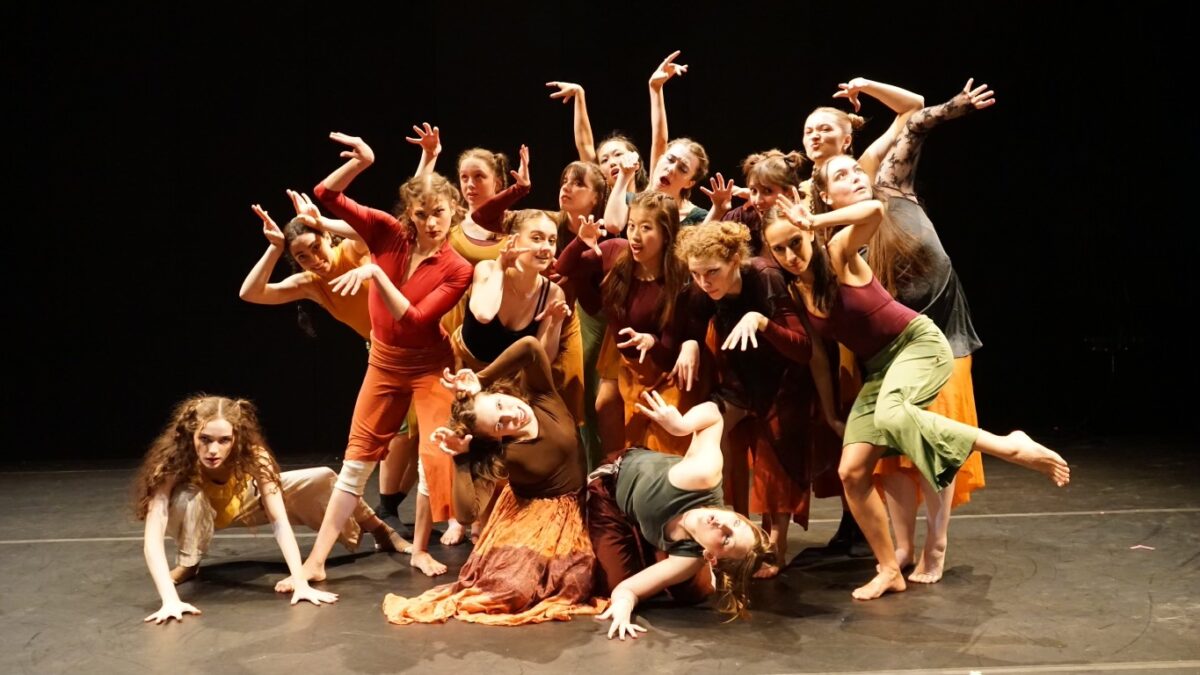Photography by Maya Shore
On March 29th and 30th, Bug Diaries: Infestation, the latest rendition of the MaMa Project, a satellite dance organization of Columbia’s dance group Orchesis, took place in Barnard’s Glicker-Milstein Theatre.
Starting in 2002, the MaMa Project offers a chosen choreographer(s) the opportunity to develop a thematic evening-length show that allows for “originality, catharsis, and creativity,” according to the Orchesis website. It is one of just a few opportunities on campus for student choreographers to create a long-form choreographic work.
“We realized that we had big ideas and ambitions — and MaMa was kind of the spot where we could make it all happen,” says this year’s choreographers/directors of the MaMa Project, Pimprenelle Behaeghel (BC ‘24) and Annika Voorheis (BC ‘24).
Behaeghel says the pair drew inspiration from her mother, a beekeeper, for the theme of this year’s performance. After spending a summer listening to her mom give talks about bees, Behaeghel and Voorheis knew there was something important to explore within bugs.
“I just kept hearing about bees, and how they ‘waggle dance’ and do a lot—they’re always in movement and they’re so interesting,” says Behaeghel. “Bugs are really a great source of inspiration for movement.”
Dim lighting and cricket sounds opened the show, as dancers laid in a circle surrounding what appeared to be a bug’s nest (imitated with a white sheet). The nest breathed and writhed before hatching, launching the dancers into the first full number, “Spiders.”
“Spiders” effortlessly highlighted dancers throughout, with elegant lifts, turns, and spotlight moments. At times, dancers bounded around the stage in a carefree manner while others were guided by geometric precision, offering a captivating introduction to the complexities of nature and insects.
Embracing a more experimental approach, “Cigarra” combined elements of tap, pointe, and contemporary. Against a backdrop of dark lighting and classical music, dancers navigated a human-sized spider web, showcasing technical finesse over high energy. It was a beautiful display of the vulnerability of bugs trapped in a web that also seemed to reflect the very human experience of resilience despite feeling out of control.
“Roly Poly” presented a buoyant contrast to “Cigarra.” Repetitive, quick movements infused the performance with an infectious energy, while maintaining a playful and lighthearted tone, ensuring that the piece never felt overly serious. It was fun, it was campy, it was light.

Photography by Pimprenelle Behaeghel
The audience collectively held its breath during “Stickbug,” as two dancers precariously balanced on the shoulders of two castmates. The piece seemed more a show of the dancers’ extensive skill set than something that propelled the performance forward, but it worked as a fun (albeit nerve-wracking) interlude among the more serious dancing.
“Slug” offered a change in pace, featuring just one dancer and a worn, gray couch. The piece flipped between panicked thrashing and numb stillness. Under a flickering overhead fluorescent light, the piece presented a raw and unfiltered portrayal of inner turmoil, eschewing conventional beauty for a stark authenticity that resonated deeply with the audience.
“It’s not something that can go in my portfolio,” jokes Joshua Halevi (CC ‘26), the show’s lighting designer, about the minimalist lighting choice. “But I think it captures the scene really well. It just feels raw.”

Photography by Pimprenelle Behaeghel
The highlight of the evening arrived with “In a Week,” which beautifully wove together set design, lighting, and evocative choreography. Set to a folk-inspired song by Hozier, the piece unraveled a poignant love story, with the dancers at times illuminated behind a white sheet. This shadowy concealment paradoxically heightens the intimacy of the story, inviting the audience to glimpse the tender moments shared by the two lovers in a uniquely personal way.
Voorheis and Behaeghel say that “In a Week” was originally inspired by lovers sleeping side by side in bed, but transformed into a reflection on love transcending death. The choreography is about “eternally being in love with the person still, even after we’ve decomposed,” says Behaeghel.
The dance culminated with one dancer launching herself into the arms of the other, a moment of reckless abandon that contrasted the contained movement of the rest of the piece. As the lighting dimmed, the pair waltzed around the stage, leaving the audience with a breathtaking picture of love, even after death.
Bug Diaries: Infestation offered a powerful and innovative exploration of beauty, transformation, joy, and death, without taking itself too seriously. The versatility of movement throughout kept the audience engaged, eager to see what next feat the cast of MaMa would take on in stride. In Behaeghel’s reflection on the closing performance, she encapsulates the essence of MaMa’s impact: the profound joy of witnessing artistic expression come to life on stage.

